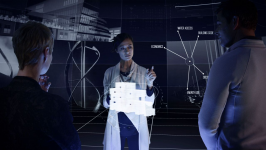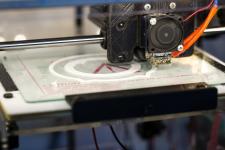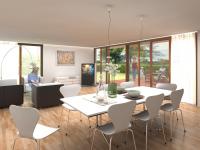The Top Visualisation Trends to Watch Out for in 2018
The Top Visualisation Trends to Watch Out for in 2018
Helping your clients to visualise your designs ensures buy-in. Anything that makes this easier helps you in selling architectural and engineering services. Here are the top visualisation trends that you should latch onto.
Imagine that you’re introducing a new concept to a client.
You’ve worked for hours on your 2D drawings and have a basic 3D model set up. You’ve even created a prototype that shows that your ideas work in practice.
You present your work to your client, but you run into a brick wall.
The client still can’t visualise what you have in your head.
It’s a common problem when selling architectural and engineering services. You need to help your clients understand what you’ve designed before you can move forward with the project. If you can’t, your client may move onto somebody who can.
The better you are at this task, the more likely you are to attract new clients. Your pitches impress and each subsequent presentation moves the project forward.
It’s all about helping the client to see what you see.
Architects and engineers already have plenty of tools at their disposal for this. Your digital design software helps you to create detailed models. A good rendering package turns them into photorealistic masterpieces. Combined, they go a long way to helping clients build an image of the project in their heads.
But you can go further.
In fact, you must go further to keep pace with your competitors and ensure you impress your clients. New technologies and trends come along all of the time that influence how you help clients to visualise your work.
This article will look at how visualisation will move forward in the year 2018. These are the top visualisation trends to start using in your pitches and presentations.
Trend #1 – Virtual Reality
The release of the HTC Vive and Oculus Rift created a new era in virtual reality hardware. No longer is it an expensive niche product that failed to reach its potential. Virtual reality is now increasingly commonplace.
Any gamers among you will already know that VR has taken the video game industry by storm. The technology immerses players into realistic worlds like never before.
You can use that same immersion to your benefit when helping clients visualise your designs.
Imagine you’re following another firm that’s just pitched for a new project. They’ve come in with a ton of drawings and models, all of which just confused the client.
Then you come in with your virtual reality hardware. Instead of trying to get your clients to understand complex drawings, you transport them into the model. You use virtual reality in an architectural walkthrough. The client gets to explore the structure as though they’re inside it. This gives them a real feel for the design you’ve created, and how it will look and feel in real life.
Your pitch impresses where the other fell short because you’ve helped the client to visualise the project.
Furthermore, virtual reality allows the user to customise the experience. Some virtual architecture software even lets you customise your model on the fly. For example, your client may ask to see a wall in another colour. A quick change is all you need to present that new colour to them in real time. The client feels in control of the project and can see what effects their ideas have.
The cost was always the main barrier to implementing virtual reality in your pitches. However, today’s hardware is more affordable than ever before. Architecture and engineering firms are already moving towards this new method of visualisation. You’ll get left behind if you don’t consider virtual reality for selling architectural and engineering services.
Trend #2 – Augmented Reality

Augmented reality (AR) is something of a sister technology to virtual reality. It helps you to enhance existing structures with new ideas.
It comes to the fore when working on new ideas for your client’s existing buildings. AR allows you to use software to layer computer-generated images onto real-life structures.
This helps with visualisation in a number of ways. Let’s say that your client wants you to redesign a staircase in their building. It’s a small job, but you still have to help the client to visualise how different designs would look.
Your 3D models can help, but augmented reality gives you the opportunity to show how the design works in real life. You can walk right into the room that contains the staircase with your client and open an app. This app uses your camera to display an image of the room on the mobile device’s screen. You then superimpose an array of new staircase designs onto the real-world image.
Your client gets to see how the new designs will look while actually standing in the building.
Much like virtual reality, augmented reality is about helping clients see how something will look in real life. It’s also very resource-light. You don’t need expensive hardware or in-depth presentations. You just open an app and impose the computer-generated image onto what you see.
This presents even more opportunities thanks to cloud computing and Building Information Modelling.
Imagine being able to install an augmented reality software on your client’s mobile device that links to your work. They can open the app at any time and access the work that you’ve done. They can then walk around their buildings, trying out different designs and providing instant feedback. You don’t even have to be there to show them.
That’s visualisation done well as it allows the client to instantly understand what they’re getting.
Trend #3 – 3D Printing

Creating a detailed model in your digital design software isn’t enough for most clients. They want to see that your design works in practice as well as in theory.
This means that there’s still a place for the real-life prototype. Typically, you’ll build this yourself. You have to order the materials, cut them to the right shapes and sizes, and fit them all together. It takes time and presents plenty of room for error. One little uncaught mistake at the start of the process means everything goes wrong. You have to scrap the model and start again.
That’s not ideal during a time-sensitive project.
3D printing may provide the answer. With a 3D printer, you take the physical building prospect away from prototype creation. Instead, you can port your model from your digital design software, and allow the printer to do the rest of the work. 3D printers also have several materials available. This lends you some flexibility in the prototype creation process.
Many architects and engineers have shied away from 3D printing because of their early impressions. The introduction of the technology made it seem incapable of handling the demands of prototyping. Printouts took a long time and materials had rough textures.
Then there was the cost. The first 3D printers cost about US$300,000 (approx. AU$371,000). That’s a huge outlay, even for the largest firms.
Today, you can buy one for about 1% of that cost. Much like with virtual reality, the price barrier has disintegrated, making 3D printing more accessible than ever.
Models now come out completely accurately and the materials used are sleek and attractive. Then there’s the fact that it saves a lot of time. Porting a model and printing it off may take a few hours. But that’s nothing compared to the days you would have spent on building it yourself.
As a result, 3D printing has become one of the top visualisation trends in the industry.
Trend #4 – 3D Animation
You may not think of 3D animation as being important for architecture and engineering. It seems like something consigned to the videogame and film industries.
Many of today’s digital design software packages allow for complex animations. You likely won’t use most of those features in your model building. However, there are many benefits that come with using a few of them.
It all comes down to creating a realistic visualisation for your client. Imagine you’re designing a building that the owners anticipate will have a lot of footfall. Presenting a model with empty corridors shows them how it will look on the basic level. But it gives them no idea of how the building will perform with people inside it. Some simple animation work allows you to populate it with people, creating a more realistic visualisation.
Beyond that, you can also use animation to create movie-like presentations. Instead of relying on yourself or the client to explore the model, your movie shows all of the important stuff for them. Think of it like a non-interactive guided tour of the model. Your basic animation links the main images together, creating a seamless presentation that’s more likely to impress.
Here’s why animation is so important. Pitching and presenting is no longer about you talking while you point at a bunch of drawings. Clients want to see your designs in action and they know that you have the technology to do it.
If you’re not using some basic animation in your models, you short-change your own presentations.
Furthermore, an animated tour helps your client spot minor issues ahead of time. This prevents delays later on in the process.
If you’re not at the stage of using virtual reality in architectural walkthroughs, 3D animation makes a good substitute. That’s why it’s one of the top visualisation trends, especially among small firms.
Trend #5 – Hyper-Realistic Rendering

There’s a common theme running through most of today’s top visualisation trends.
Most clients want to see as realistic a depiction of your work as possible. They need to see how it all works in real life before they’ll give you the go ahead.
The previous four trends all use external technology and features to make your models look impressive. But trend five relates to how you render your basic model. That’s something you’ve done for years, but it’s how you do it that’s changing.
You rarely present the base model that you built in your digital design software to your client. Most use a rendering package, such as V-Ray, to give it some sparkle before presenting.
In the past, realism was less of an issue with rendering. The technology wasn’t able to create photorealistic renders for your models.
Now, it is. And your clients want to see that photorealism in the models that you present.
Realistic renders benefit architects and engineers in several ways. They help with client visualisation, as you’re not asking the viewer to work around the constraints of your technology. Photorealism also allows for quicker spotting of compliance issues. Better yet, it raises your clients’ confidence in you.
You don’t experience any of these benefits if you opt for the most basic rendering package around. It’s not just about tidying up the base model anymore. Your render is key to helping clients figure out how the design will look in real life. Simple renders don’t cut it. They place too many demands on clients, especially when others present more realistic depictions.
Conclusion
So, what makes these the top visualisation trends in architecture and engineering?
Each of these trends help your clients to understand your designs. With photorealistic rendering, they can see how the model looks in real life. 3D printing allows you to create quality prototypes faster, and clever use of animation gives the presentation some more pop.
Then there are the newer technologies. Virtual and augmented reality let you guide the client through your work. You don’t have to worry so much about explaining your ideas. Clients can see the ideas in front of them.
These trends don’t just benefit clients though. Each also has a tangible benefit for your firm. They help you to spot design flaws and cut both costs and time. As a result, each helps your firm to develop a reputation for high-quality and speedy delivery.
Nevertheless, many firms are still dragging their feet about adopting these methods. Don’t let that be you. Help is available if you want to ensure your firm stays on top of the latest visualisation trends.
That’s where ArchiStar Academy can help. We provide courses in several digital design software and rendering packages. We can also show you how to use the software packages that incorporate VR and AR into the mix.
Are you looking to get started? Then contact ArchiStar today to find out how we can help you adapt to today’s top visualisation trends.
ArchiStar Academy offers several courses across the spectrum of digital design software. You’ll develop your skills, allowing you to create more accurate and functional models.
Please don’t hesitate to get in touch with Archistar Academy today if you have any questions.
If you would like to share your thoughts on our blog, we’d love to hear from you!
Get in touch with the ArchiStar Academy [dev] community via Facebook.
Posted on 20 Jan 2020
![ArchiStar Academy [dev] logotype](https://academy.archistar.io/images/archistarr-academy.png)
